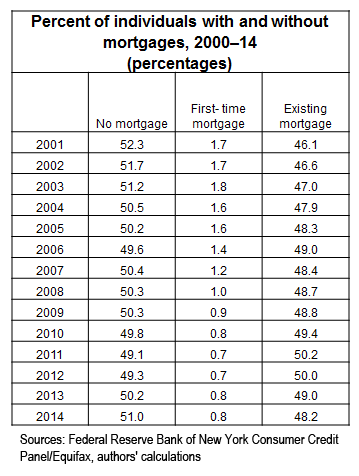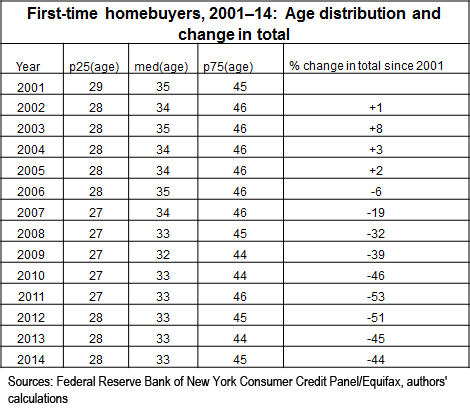First-time homebuyers play a critical role in the housing market because they allow existing homebuyers to sell their homes and trade up, triggering a cascade of home sales. While their share of all purchases has remained fairly flat over time (see our previous post on this topic), the number of first-time homebuyers has declined precipitously since the real estate crash. Many think of first-time homebuyers as younger households, and believe millennials are largely behind the decline in first-time homebuying. There are a variety of theories about why millennials have been slow to enter homeownership. One theory says that millennials would rather rent in dense urban areas where land is scarce than buy homes in the suburbs. Another theory blames steep increases in student debt for crowding out mortgage debt and reducing the homeownership opportunities of younger generations. Yet another theory argues that because the recession lowered incomes, younger people can't afford to buy. Finally, underwriting standards tightened after the recession, causing mortgage lenders to require larger down payments and higher credit scores in order to buy a home. Some worry that this more stringent lending environment has raised the bar too high for millennial homebuyers in particular.
We can't examine all these theories in a blog post, but we can examine the validity of the assumption that millennials are driving the decline in first-time homebuyers. We approached this from two angles. We first looked at whether the age distribution of first-time homebuyers has changed, and then we tried to discern patterns in first-time home buying across states. In general, we find that the age distribution of first-time homebuyers has become younger, not older, since the crisis. We also found that the dramatic fall in purchases varies much more strongly across states than by age. The preliminary figures suggest that housing market and local economic conditions may explain as much or more of the decline in first-time homebuyers than a generational divide.
Searching the data for first mortgages
Our analysis is based on the Federal Reserve Bank of New York Consumer Credit Panel/Equifax data. This data set provides longitudinal, individual data, using a 5 percent sample of all persons with a credit record and social security number in the United States.i We examined the age, location, and credit scores of people who bought homes for the first time and looked at how these characteristics changed after the crisis.ii
To identify first-time homebuyers, we flagged the first year of the oldest mortgage for each individual in the credit panel. This reveals the first instance of someone obtaining a mortgage, even if they subsequently buy another home or even transition back to renting. The trade-off is we were able to observe only those who use debt finance, and thereby excluded all cash purchases. While many homeowners do own their homes outright, we expect most first-time buyers and certainly most young buyers to have a mortgage.iii
Having isolated first-time homebuyers in this data set, we looked at their purchasing trends and demographic attributes from 2000 to 2014. In this data set, we found that roughly 1 percent to 2 percent of the population purchased a mortgage-financed home for the first time in a given year. Forty-nine percent to 53 percent had no mortgage (this category combines renters and those who own their homes outright), and 45 percent to 50 percent were paying down an existing mortgage.
Buyers aren't getting older
We found that the number of first-time home buyers fell precipitously after the crash, from 3.3 million a year to around 1.5 million to 1.8 million. However, the age distribution of these first-time homebuyers does not change dramatically, though the median age of actually went down slightly since the peak. If we were to believe that the decline in first-time buyers was driven primarily by younger workers requiring more time to amass a down payment or pay off student debts, then we would expect to see first-time buyers getting older.
We did not see a strong explanation for dramatic declines in first-time homebuyers when we compared younger and older adults. It doesn't appear that millennials are driving the decline. By comparison, when we reviewed the number of first-time home purchases by state, we found very dramatic differences that population alone cannot explain. Unsurprisingly, first-time homebuying fell further in places where the housing crisis hit the hardest.
The chart shows the number and percent change in first-time homebuyers from 2001 to 2011 by state. There is a wide variety in the percent change in first-time homebuyers, with declines as strong as 65 percent in some states and as low as 10 percent in others. North Dakota was the only state to have increases in first-time homebuyers, likely due to the oil industry growth there.
This analysis does have some weaknesses. For one, as we mentioned, it omits cash buyers, who are an increasingly important segment of the housing market, especially in hard-hit states like Georgia and Florida. Also, other research has shown that the transition from renter to owner and back can happen many times in a person's lifetime, and this data set does not control for homeownership "spells" older than one year (see Boehn and Schlottman 2008). Notwithstanding, this analysis suggests that the decline in first-time homebuying is driven not by swiftly changing preferences nor the economic constraints of the younger generation but by regional and local economic conditions. Stay tuned for more, as we plan to look further into how the real estate crisis altered the home purchase decisions of young first-time homebuyers relative to older generations.
 By Elora Raymond, graduate research assistant, Center for Real Estate Analytics in the Atlanta Fed's research department, and doctoral student, School of City and Regional Planning at the Georgia Institute of Technology, and
By Elora Raymond, graduate research assistant, Center for Real Estate Analytics in the Atlanta Fed's research department, and doctoral student, School of City and Regional Planning at the Georgia Institute of Technology, and
 Jessica Dill, economic policy analysis specialist in the Atlanta Fed's research department
Jessica Dill, economic policy analysis specialist in the Atlanta Fed's research department
_______________________________________
i The data is a 2.5 percent sample of all individuals with a credit history in the United States. So, for example, this sample resulted in 636,638 records in 2014, which would correspond to an estimated 254,655,200 individuals with credit records and social security numbers in 2014.
ii We excluded anyone who had an older mortgage in a prior year. Doing so resulted in only a very small percentage of records being excluded.
iii Our approach and results are similar to those cited in Agarwal, Hu, and Huang (2014), who find that the homeownership rate between 1999 and 2012 varies between 44 percent and 47 percent for individuals aged 25—60 using a different time frame and age distribution of the same data set. Because our definition—and that of Agarwal, Hu, and Huang—is unique, it differs from the widely cited homeownership rate published by the U.S. Census Bureau. The rate published by the Census Bureau ranges between 65 and 68 percent for individuals over 25 years old and is calculated by dividing the number of owner-occupied households by the total number of occupied households. Homeownership rates have also been derived using other data. Gicheva and Thompson (2014) derive a homeownership rate using the Survey of Consumer Finance and find the mean homeownership rate to be 61 percent between 1995 and 2010. Gerardi, Rosen, and Willen (2007) used the Panel Survey of Income Dynamics (PSID), which tracks households over time and captures changes in tenure status, to identify home purchasers. They reported a range of 5.6 percent (in 1983) to 9.6 percent (in 1978) of households buying homes in the 1969—99 timeframe.




